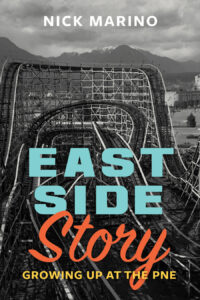 Having visited Vancouver many times throughout my life, I was intrigued by Nick Marino’s East Side Story: Growing Up at the PNE, a historical retelling of his childhood growing up as a cog in the PNE’s wooden wheels. What I wasn’t expecting was the emotional whiplash I experienced reading about the ups and downs of not only Marino’s life, but also the history of Canada.
Having visited Vancouver many times throughout my life, I was intrigued by Nick Marino’s East Side Story: Growing Up at the PNE, a historical retelling of his childhood growing up as a cog in the PNE’s wooden wheels. What I wasn’t expecting was the emotional whiplash I experienced reading about the ups and downs of not only Marino’s life, but also the history of Canada.
Marino takes his readers on decades of rides starting as early as WWII, before the ginormous wooden roller coaster at the PNE was built. He talks about his youth working in one of the many games at the PNE during the ’80s. The PNE was the place for the youth of Vancouver to work for a couple weeks in the summer, meet new people, and skim some money off the top. Marino lightly speaks about the almost unspoken agreement between the youth working at the PNE to give out free games and to fudge the books to pocket a few $20s. The laissez faire feel to work and responsibility is beautifully portrayed in Marino’s memories of riding his bike across the border to buy cigarettes as a kid and the breaking and entering that many youths of the time partook in.
I’d never heard of Miss PNE, a beauty contest that started in the 1940s, and I appreciate Marino bringing it to light today. He talks about how the contestants’ weight and chest and hip size were published for all to see in the newspapers. Gross. (These women were teenagers, making the whole thing feel even worse.)
One of the most important chapters in Marino’s book is his telling of the Japanese incarceration camps. This is part of our history that I was unaware of. Having read about it now, it feels like such a significant event, and I’m surprised I wasn’t taught about it before. During WWII, the Canadian government was so terrified of an attack from Japan that they decided to round up all people of Japanese descent, including those who were born in Canada, and put them in inhumane camps, just in case they were planning an attack from the inside (I can’t express enough of an eyeroll here). So, on one side of the PNE grounds was the Happyland Dance Hall and on the other was barbed wire enclosing approximately 8,000 people for weeks or months, forcing them to live in horse stalls and conditions not fit for any living creature. 22,000 Japanese Canadians were incarcerated in Canada and forced into different camps across the country, losing their homes and belongings, which the government auctioned off.
Marino has a way of telling his history, and the history of Canada, with humour, heart, and significance. I was unsure of what to expect from East Side Story, but I wasn’t expecting such an emotive book. I’d recommend it to anyone who wants to experience the joy of a summer at the PNE while also learning about the struggles of Canadians, both small and giant roller-coaster sized.
